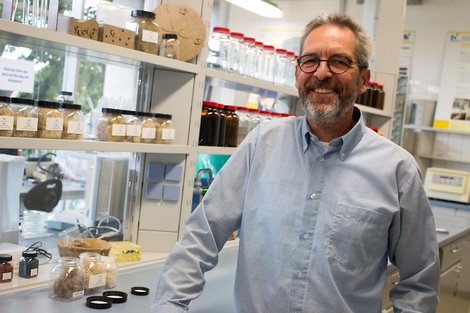Nature’s intelligent ideas advancing materials research

An industrial laboratory at Magdeburg-Stendal University of Applied Sciences is researching materials that are made from renewable raw materials
With their good ecological balance, natural fibres are becoming increasingly important for the research and development of lightweight and intelligent materials. The Competence Centre for Engineering Sciences/Renewable Resources at Magdeburg-Stendal University of Applied Sciences focuses on fibre-polymer composites – materials with completely new properties.
“Marathon enthusiasts are eagerly awaiting the runner who will be the first to cover the distance in less than two hours,” says Peter Gerth – and not because he himself is a top runner, but because he is a materials researcher. According to Gerth, it is the lightness and intelligence of the shoe sole that could make a decisive contribution to breaking the record. The scientist knows exactly what he’s talking about. He is the Spokesman of the Competence Centre for Engineering Sciences/Renewable Resources, an industrial laboratory at Magdeburg-Stendal University of Applied Sciences. Bio-materials are a particular focus of the research at this institution. In the course of the continuous further development of modern technologies, a great deal of potential can still be taken from nature, Gerth says, before returning to the topic of the “intelligent shoe sole”. “DiaBSmart” is an EU research project in which partners from the worlds of medicine, industry and research in India, Spain, Great Britain and Germany are developing a new type of footwear for diabetics. The intelligent sole is intended to compensate for the impaired sensation of temperature and pain on the part of the diabetics. Innovative materials enable significant pressure relief at the critical points of the foot. The Magdeburg-based materials researchers applied their expertise to their development. “A partner hospital in India carried out the clinical investigations and has certified that the material has good properties for this area of application,” says Peter Gerth, adding that the diabetic shoe is to be further developed in a follow-up project until it is ready for the market. However: Brexit is currently suspending the activities.
All the same, the results from materials research surrounding shoes are playing a major role. Sports shoes also require special mechanical properties. A sole plate made from a special natural fibre composite material can return up to two percent of the energy to the runner, explains the scientist Gerth, announcing a new finding which is of particular interest to shoe manufacturers. “The first question of which marathon runner has broken the world record is followed by the question of the kind of shoes that he was wearing,” says Gerth, and confirms the Competence Centre’s contacts with companies in this sector.
Ecological rethinking that opens up new fields of business
The very own task of the Competence Centre Engineering Sciences/Renewable Resources is the transfer of knowledge and technology, above all else to the regional economy. With the practical knowledge of the professors and the state-of-the-art laboratories, Magdeburg-Stendal University of Applied Sciences can offer ready-to-use know-how, explains Transfer Officer Peter Rauschenbach. His task is to reconcile the requirements of the companies with the research offers at the university. These range from consulting and laboratory services through to joint research and development projects. “We have just signed a cooperation agreement with a filter manufacturer from Saxony-Anhalt which is about filtering out microfibres from waste water,” says Peter Rauschenbach, adding that in this way, the company is opening up a new business segment. Peter Gerth continues: “The need for research is growing, especially in terms of environmental behaviour. The economy requires efficient and ecologically justifiable manufacturing processes for environmentally-friendly products. The materials are therefore of considerable importance. Together with players from the world of industry, Fraunhofer and Leibniz institutes, and from universities and colleges, we develop materials made of natural fibres and fibre-reinforced polymers which, due to their mechanical properties, are suitable for a variety of applications in general lightweight constructions.” In view of the alarming news about the discovery of micro-plastics, even in the snow of the Alps and the ice of the Arctic, he emphasises the material use of renewable raw materials. “Bio-polymers have an improved greenhouse gas balance and reduce the demand for oil.”
High performance materials from renewable raw materials
A new cooperation project at the Competence Centre for Engineering Sciences/Renewable Resources is addressing the optimisation of the material properties of bio-polymers through fibre reinforcement. In this context, according to the materials researcher, bacteria would be used to obtain nano-cellulose fibres in the desired length and quantity. At the University of Magdeburg-Stendal, the processing of nano-cellulose fibres is being tested for the first time and processed as a reinforcement of composite materials so as to test their application properties. The material, which is made 100 percent from renewable resources, could be used as a high-performance coating in the food sector; for example, as a barrier on packaging materials that prevents moisture from escaping and oxygen from entering so as to guarantee a longer shelf life, explains Peter Gerth, referring to the successful completion of the feasibility study. The application of bacterial nano-cellulose under industrial conditions is the next step. “In this way,” explains the spokesman of the Competence Centre, “we are not only continuously expanding the research infrastructure in Saxony-Anhalt, but we also operate and get known beyond the boundaries of the federal state. After all, composites with natural fibres are suitable for many applications.” New areas of application are constantly opening up for the competence centre, such as the care sector. Service providers have already approached the materials researchers with their ideas about special textiles, explains Peter Gerth.
Author: Kathrain Graubaum
Read HERE what Saxony-Anhalt offers in the field of smart materials. HERE materials think smart.
